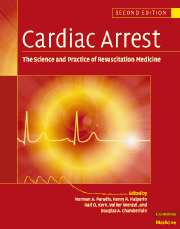Book contents
- Frontmatter
- Contents
- List of contributors
- Foreword
- Preface
- Part I Introduction
- Part II Basic science
- Part III The pathophysiology of global ischemia and reperfusion
- Part IV Therapy of sudden death
- Part V Postresuscitation disease and its care
- Part VI Special resuscitation circumstances
- Part VII Special issues in resuscitation
- Index
Preface
Published online by Cambridge University Press: 06 January 2010
- Frontmatter
- Contents
- List of contributors
- Foreword
- Preface
- Part I Introduction
- Part II Basic science
- Part III The pathophysiology of global ischemia and reperfusion
- Part IV Therapy of sudden death
- Part V Postresuscitation disease and its care
- Part VI Special resuscitation circumstances
- Part VII Special issues in resuscitation
- Index
Summary
O, that I could but call these dead to life!
King Henry VI William ShakespeareThere is a no more frightening experience for a clinician than a patient's sudden and complete loss of vital signs. The need to initiate multiple complex therapies, all the while knowing that each minute that passes dramatically decreases the chances for a good outcome, makes sudden death the penultimate medical emergency.
Premature death is the adversary of physicians. For millennia, the loss of life signs was considered the victory of death. Students were taught that once patients had succumbed they were beyond the healing arts. Only relatively recently have physicians regularly attempted to wrest such patients back from death.
Accurate numbers are difficult to obtain. It is said that more than 300,000 persons die each year from sudden cardiac death in the United States alone. Worldwide the figure is in the millions. Sudden death is not, however,caused by coronary artery disease alone. Hemorrhage and asphyxiation, among others, can kill physiologically competent patients without warning. Sudden death is not defined by etiology; it is the circumstance of cardiopulmonary arrest in a person with functional vital organ systems. It is death in the midst of life, and it is always tragic.
We are just beginning to appreciate the magnitude of this problem and the potential for therapy. Just a 5% improvement in outcome – something that could be achieved in many communities by better application of standard care – would save more lives than therapies that have received far more attention. The potential for good is astounding; the relationship of cost to benefit compelling.
- Type
- Chapter
- Information
- Cardiac ArrestThe Science and Practice of Resuscitation Medicine, pp. xxxi - xxxivPublisher: Cambridge University PressPrint publication year: 2007



